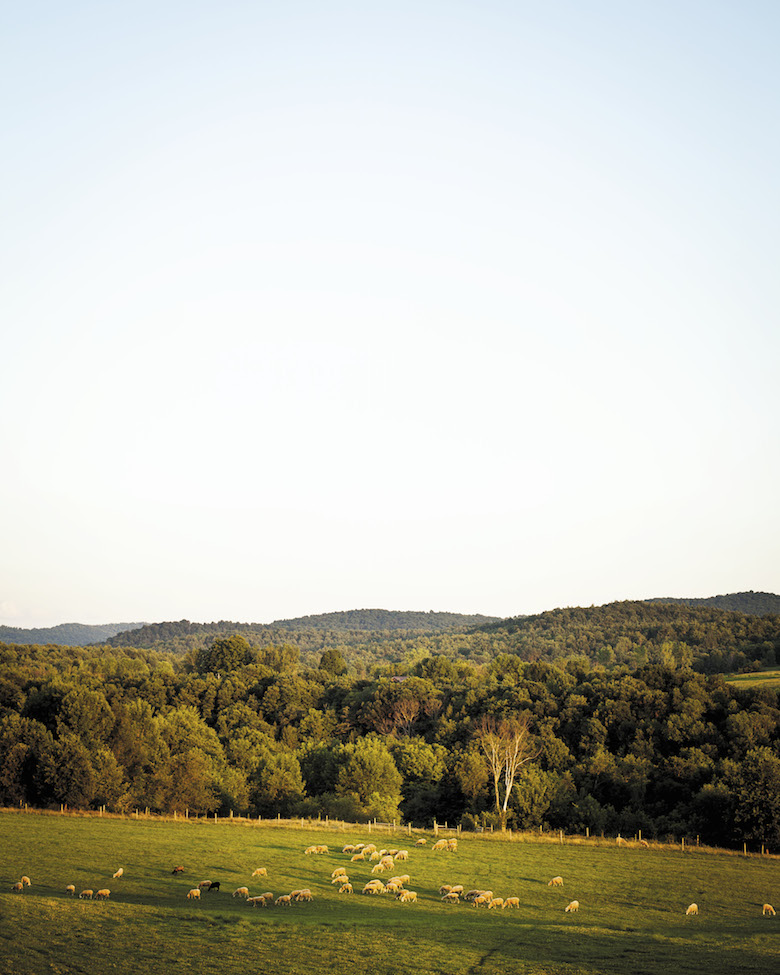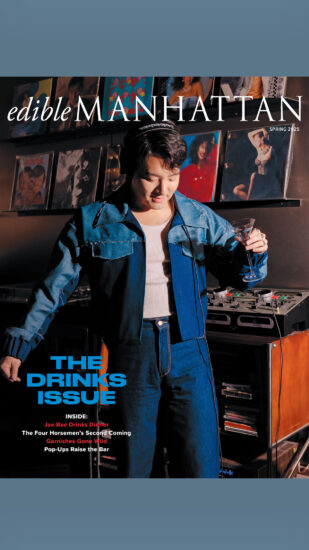The sheep’s ricotta, aged pecorino and cured salame sold at Fairway and served at Per Se may taste like Italian imports, but hardcore locavores can rest easy. They’re made upstate, where one little family’s farmstead cheese and charcuterie rivals the best stuff shipped across the Atlantic.
For Jody Somers and Luisa Scivola-Somers at Dancing Ewe Farm, about 20 miles east of Glens Falls near the Vermont border, authenticity represents the sine qua non for everything they make. Though the breeds of livestock, the pastures’ flora and the microbial population of the aging rooms are all completely unlike what you’d find in Tuscany, the results are startlingly accurate.
The raw pecorino fresco is nutty and firm, aged just 60 days, while the stagionato (aged one year and rubbed with olive oil and tomato paste) is sharp, assertive and lingers on the tongue with sheepy, grassy overtones. The riserva, aged two years in larger wheels, attains the crumbly, gratable hardness of true Parmigiano.
Somers grew up raising sheep (for wool and meat, not milk) and sheep dogs on this very farm; his mother still raises and trains dogs as a hobby. His love for animals led him to veterinary school at Texas A&M, but his plan to do equine surgery eventually lost its appeal and he moved back to the farm in 2000. Around this time he read that lactic bible Cheese Primer by Fairway’s famous monger Steve Jenkins and reached out.
“I called him up and asked ‘Where should I go to learn how to make sheep cheese?’” “Tuscany,” replied Jenkins. “Nobody’s making pecorino around here.”
Somers found a six-month course at La Parrina in Orbetello, and flew over. But he didn’t just learn the art of Italian cheesemaking, he also met Scivola, who worked at the farm, and the two became friends.
He’d left home uncertain about his future, but returned determined to make cheese and set to work breeding his mother’s wool ewes with Friesian rams, a famous dairy breed. Scivola accepted his invitation to come visit America, “and one thing led to another,” he smiles, bouncing their toddler, Matteo, a veritable cherub, on his knee.
Scivola hails from Manciano, a small town in the southwestern corner of Tuscany, closer to Rome than to Florence. She grew up on a subsistence farm that also sold milk and olive oil and had a vineyard. Now she’s right at home on 50 acres of pasture and woods that slope down from the road to the Mettawee River. Somers is garrulous, with boundless energy, while Scivola is taciturn, though quick to smile. She will often cede the floor to him, but it’s clear that she is the ultimate authority. He tends the sheep, makes the cheese and does the bulk of the charcuterie work. She takes care of the business side and serves as quality control officer; nothing goes out the door if it does not meet her exacting standards.
Somers makes pecorino whey into ricotta in a huge steel vat inside the cheese house. Perched on a little platform at the top of a spiral ladder, deftly scooping the floating curds into plastic baskets with a flat metal spoon, whey trickling noisily back into the vat, he recalls the parlous early days of expensive infrastructure.
“We restored this building [a former tractor shed] with recycled shipping pallets, bought this tank and a few other things. Then we were pretty much dead in the water; the loan was used up.” They were saved when Hollywood came calling; HBO needed sheep and dogs for A Dog Year, starring Jeff Bridges. “That gave us a good chunk of money. It paid for the aging rooms and really got us going.”
Ricotta is made by reheating the whey left over after making cheese, in this case the pecorino. (The word “ricotta” is Italian for “recooked”). It has the advantage of being ready to eat the day it’s made, as opposed to the long-aged pecorino. Once they began producing cheese, Somers recalls, “I called Steve up again and said ‘Remember me? Can I bring you some ricotta?’” They drove down to Fairway, and Jenkins was so impressed that he immediately connected them with Florence Fabricant. Through her, he landed sales to Babbo, Daniel and Per Se.
The combination of pastured milk and the Italian cultures made for a powerful product. “Once we had them as customers, other doors opened pretty easily,” says Somers.
Scivola’s uncle and cousins own a farm in the Tuscan town where she grew up, and the couple decamps to Italy every August to make fig jam and pepperoncini sott’olio, and again in winter to help with the olive oil harvest and pressing, bringing back bottles of olive oil and a few wines for New York customers, available through their website. Their full line, a hybrid of Italian and American products, makes them a one-stop destination for the best picnic or antipasto spread you’ve had in a long while.
Three years ago the couple took a dramatic step, broadening not only their repertoire but the locavore food scene: They began making their own charcuterie, using Scivola’s mother’s recipes. “We always had pigs at the farm,” she recalls of her Tuscan childhood, “and every January we slaughtered a pig and the town butcher would cut it up, freeze some, and we’d cure the rest.” The charcuterie — capocollo, crusted with pepper; cacciatorini, skinny and sweet (they include 25 percent local venison); and finochiella, flavored with fennel pollen and hot pepper — let the flavor of the meat shine, flattering it with spices and the addictive tang of fermentation.
Their pork is raised nearby by Kevin Goodspeed, who also helps out at Dancing Ewe. After the twice-weekly pecorino and ricotta making is complete, Goodspeed takes all of the whey to feed his animals. This cycle, where whey is fed to pigs, mimics the same practice in Parma, where Parmigiano whey is fed to the pigs destined to become that region’s famous prosciutto. Here at Dancing Ewe, the meat becomes bresaola and pancetta.
Fronting the road, all in a line, sit their house, the aging rooms, the caseificio (creamery), the barn and a multipurpose structure built with a recent loan. Besides storing hay for winter feed, it contains a state-of-the-art charcuterie facility set up by experts flown in from Italy.
Manhattanites who want a taste can try mail order or, better yet, a meal: The couple host regular weekend lunches and dinners for up to 40 guests. At gorgeous tables out in the fields, they showcase their handmade ingredients and Scivola’s estimable prowess in the kitchen.
Upstairs, eventually, two bedrooms will be built to accommodate agritourists keen to get the full experience (and enjoy the wine). They also have plans for a brick pizza oven in the tasting room.
Sitting down to a lunch of grilled bread and their cheeses, charcuterie, jams and wine, Somers shows off the wine glasses they bought for the dinners. Just on the other side of the wall, festooned with little white Christmas lights, sits a big ziggurat of hay bales next to a sprawling array of tools and building materials.
“Did you salt the pasta water?” Scivola suddenly asks in alarm.
“No, I forgot,” he replies sheepishly. “She’s going to kill me later,” he mutters sotto voce as she rushes into the kitchen to remedy the disaster.
Returning, she explains, “If you don’t salt the water, it just boils and becomes soft, like American pasta.”
Her disdain is evident, and yet the result, tossed with mushrooms, their fresh ricotta and copious lashings of their vivid green olive oil (from an amphora-shaped bottle with a Dancing Ewe label) easily transcends the mishap. Then again, the ricotta is so fluffy and sweet that this magazine’s pages would be palatable if slathered with enough of it.
After numerous delays and problems with the charcuterie climate-control system, a high-end Italian mechanism designed to keep four different rooms at specific temperatures and humidities over the course of the charcuterie’s evolution, the Italian technicians, who flew over to install it — Somers likens it to a Ferrari — have departed for what Somers hopes was the last time. Inspired by a failure of the $15,000 computer that governs the climate in the aging rooms — which necessitated throwing out a whole batch of salami — the couple sells fresh sausages, which allow them to turn pork into income without a long curing period.
The four excellent flavors include rosemary, truffle, Morellino (made with red wine) and a particularly interesting example with parboiled potato chunks called Sartuccio, after the man who taught them the recipe. “It’s starvation food,” explains Somers. “They would add potatoes to the meat to stretch it out and make it last longer.” It also happens to taste delicious, and obviates the need for potatoes alongside. All the fresh sausages are seasoned with a light touch, he continues “because when the pork is this good, you shouldn’t bury it in spices.”
They practice rotational grazing, moving the sheep regularly to new pastures where the grass has had time to regrow after the sheep’s last visit. The farm received organic certification from NOFA for their pastures, though not for their cheese; they believe strongly that the only things a meadow needs are rainwater and sheep shit, but Somers’ expert opinion is that the animals prosper more with occasional interventions, especially for parasites. For this same reason, lambs are kept indoors and fed clean hay and pure water until they get big enough to handle the bugs out in the world.
Walking down a path toward the river, where the sheep are grazing in the shade of some trees above its bank, Somers says adding value, by selling cheese and salami rather than just milk and meat, offer farmers a way to earn a respectable income for their hard work. Every weekend they sell at farmers markets in Troy, Saratoga and Rhinebeck, and are increasing their wholesale and mail order business, shipping cheese, salumi, wine, jams and sott’oli (pepperoncini and sun-dried tomatoes).
Seeing us, and more specifically Will the dog (who also starred in the movie), the sheep obediently crowd in front of the gate, waiting to be moved to greener pasture, though it is not yet time. As we turn back up the hill, leaving their annoyed bleating behind us, Somers continues.
“We’re really excited about the charcuterie. It’s fun to learn something new. I can make cheese in my sleep now, and we know the cheeses are good. We take them to Italy and people like them. That’s the stamp of approval I care about.”
Twice a year, Somers and Scivola head to her family’s Tuscan farm to help tend the olives. Read about the 2014 harvest here.
Photo credit: Eric Medsker (1-6), Peter Barrett (7)



